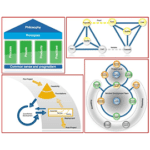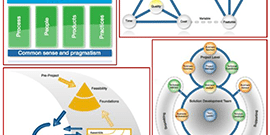 We’re increasingly hearing about ‘Agile’ it seems to be becoming a buzzword perhaps starting to go viral. But what really is it? And why should we all take an interest?
We’re increasingly hearing about ‘Agile’ it seems to be becoming a buzzword perhaps starting to go viral. But what really is it? And why should we all take an interest?
Look it up in the dictionary and you’ll likely find two meanings:
Firstly its common everyday use – ‘able to move quickly and easily’ with synonyms such as ‘nimble’, ‘sprightly’, ‘supple’ and others.
Secondly its business meaning – ‘relating to or denoting a method of project management, used especially for software development, that is characterised by the division of tasks into short phases of work and frequent reassessment and adaptation of plans’: Contrasted with ‘waterfall’ (traditional project management approaches).
Now of course we’re particularly interested in this second business meaning – but the world has moved on since this definition was drafted. ‘Agile’ is becoming more than just project management, and no longer largely just for software development. This was visibly demonstrated last autumn with the formal launch of the new ‘Agile Business Change Framework’ at a conference in London held by the renamed ‘Agile Business Consortium’ – formerly the DSDM (Dynamic System Development Method) Consortium. The new Framework is designed to support businesses and organisations in adopting Agile principles and practices at any organisational level and on any scale.
The Agile Business Framework has the following additional elements (beyond its Agile Projects core):
- Agile Product Evolution – this will broaden the scope of product evolution from software development to include business products too.
- Agile Service Evolution – with or without IT enablement business services and processes will benefit from the application of Agile principles
- Agile Programmes – scaling up from Agile projects for whole–business capability change
- Agile Strategy and Portfolio – Agile Business Change scaled to the highest level
- Agile Culture and Leadership – inspiring people to engage with each other and their customers, collaborating to deliver real business value as quickly and efficiently as they can.
- Agile Enablement and Governance – governance centred around engaging people with the right knowledge and skills to do the right thing in the right way whilst promoting an environment where truth, trust and transparency is the norm.
In short Agile will apply to the entire Business Improvement, Operational and Strategic Excellence space. So we should be interested. When fully evolved and deployed it potentially promises us:
- Faster improvement projects – wouldn’t it be brilliant if we can complete a Lean Six Sigma project in as many weeks as it takes months today (or days instead of weeks)?
- Faster service and product development and innovation – a new enhancement to Lean Six Sigma for Innovation and Development (or DfSS if you must).
- More nimble business strategy development and deployment – and the ability to flex in an increasingly rapidly changing environment
- Reinforcement of the best Change Management approaches – including ‘Servant Leadership’ – focusing on those who most directly interface with our customers
Some features of Agile we already use – Scrums and Sprints for example are as applicable in DMAIC projects as they are in software development ones. Others we will come to adopt and adapt. I envisage a future in which the fusion of Lean with Six Sigma (LSS) now also fuses with Agile to give us the best of all these improvement approaches.
So you’ll be hearing more about Agile from Catalyst over the coming months. For now we’re starting with launching our own Agile Project Management training – working collaboratively with Andrew Craddick’s people at nlighten. You will see this in our Open Training schedules and also available as an in-company training programme from this spring onwards. This course is fully accredited by the Agile Business Consortium. Over time we will be making further announcements about new Agile training and consulting products and services, many of them integrated with our Lean Six Sigma ones. So please watch this space – and of course let us know if you have particular Agile requirements – we promise to be Agile in responding!
You’ll also be pleased to know that Catalyst is up front working with and as a member of the Agile Business Consortium in the ongoing development of the Agile Business Framework – just as we were with the original development of the EFQM Excellence Model.
Catalyst has always been agile in the way in which we work. Those of you who know us well will recognise that. It’s nice to know that we’ve always been ahead of the game in how we’re run our own business.
Agile is ultimately about delivering Value to Customers! That’s precisely what Catalyst is in business to do – remember our tag line ‘Enabling Results’!









